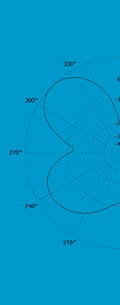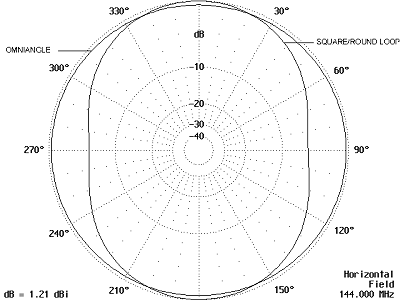 All materials on this site © PAR Electronics, Inc.
All materials on this site © PAR Electronics, Inc.
PAR Electronics, Inc.
P.O Box 645
Glenville, NC 28736
Voice: 828-743-1338
Fax: 866-304-8479
Email us if you have questions or comments about this site.
Site by
Pinnacle Web Design
Omni-angle Antennas FAQ
- The Omniangle shape does not look as though it would provide as good an omni pattern as a round loop.
- Agreed. However, this is deceiving. The azimuth patterns of
classic round or square loops are actually elliptical or
egg-shaped (the ideal omni pattern would be a circle) due to the
diminishing currents toward the ends of the loops.

Omniangles use what we term pattern synthesis to achieve a much better omni pattern than the round or square loops. This is accomplished by a longer electrical length and the triangular shape. By varying the shape and length, we can synthesize a pattern that is within +/- 0.5dB of a perfect omni pattern. Compare this with the 4-6dB "out of round" patterns that are typical of round and square loops. - Are there other advantages of the Omniangle design?
- Yes. The longer electrical length provides additional gain- not a lot but it is measurable. This brings up the question about comparing omnis. Look at the azimuth patterns of an Omniangle versus a classic square loop. Note that off the front and rear, the loop has a bit more gain; and if this were the only measurement made, it would appear that the loop was the better antenna. But now look at the sides- the Omniangle has a clear and sizeable gain advantage over quite a large compass swath. In order to completely characterize an omni's Gain, measurements must be made say every 10 degrees and then averaged.
- Is a balun important on an omni?
- We think so. Just as in the case of a dipole, omnis are a balanced antenna. Feeding the omni with coaxial cable may result in antenna or radiation currents on the outside of the coaxial shield. If your goal is to have an omni pattern and to have all the energy in the horizontal plane, then having the feedline radiating is NOT the way to accomplish this. All of the Omniangles contain a current mode balun built into the matchbox. Some years back, a KH6 amateur ordered an OA-50 from us for use on a 6M beacon. Previous omnis had severely detuned in this rainy tropical climate destroying the beacon P.A.. He reported that the Omniangle had solved the detuning problem, but an amateur on another island who had previously received the beacon, could no longer hear it. This was initially puzzling. In my next E-mail, I asked the beacon owner to find out what antenna the islander was using. It turned out he was using a vertical! The previous 2 loops were radiating energy fro the vertical feedline coming from the loop. The balun on the Omniangle prevented this and as a result, virtually eliminated the vertical component.
- What is the gain of an Omniangle?
- Modeling indicates gain to be about -IdBd. This should not be surprising if one considers that we are pretty much taking the figure "8" pattern of a dipole and reshaping it into a circle. In order to fill in the two null areas of the dipole pattern, we borrow energy from the dipole's main lobes. Now, because the Omniangles are longer than a /2 wave dipole, we get some of the gain back. Compared with classic loops (shorter than /2 wavelength dipole) the Omniangles come out about +0.5dB better. Getting back to the -IdBd gain. Note that in order for the dipole to maintain this gain over all compass directions, it would HAVE to be rotated, whereas the omni displays its -IdBd gain in all directions continuously.
- At east one manufacturer claims gain well above a dipole. What gives?
- They are including ground reflection gain which typically runs 4 to 5dB. This is real gain that vertical antennas do not have access to. But to be correct, a dipole above ground also accesses this same 4-5 dB gain.
- Does stackingOmniangles achieve gain?
- Yes, if done properly. Either a quarter wave 75 Ohm harness or a power divider must be used. Optimum stacking distance is between 5/8->3/4 wavelength and is relatively non critical. The resulting gain is close to the theoretical +3dB. Stacking at distances of /2 wavelength and below is not worth the cost and effort. Both antennas must be mounted so they face the same direction and have their connectors facing down.
- Why horizontal polarity?
- Horizontal polarity has long been the de facto standard for CW/SSB work. Horizontal antennas are generally less susceptible to man made noise and as mentioned previously, can take advantage of ground refection gain that verticals do not have access to. For local FM work (vertically polarized) you will suffer a -20dB cross polarity penalty. This will not be the case when communicating via ionospherically reflected signals- aurora, sporadic E, F2 layer TEP.
- Do Omniangles require a tuner?
- No. Omniangles are perhaps the easiest antennas to tune, requiring no tools. An antenna analyser or a transceiver with a VHF/UHF VSWR meter or VHF/UHF wattmeter is all that is required. TAKE THE TIME TO TUNE THE ANTENNA. There seems to be a trend today to let an antenna tuner provide the match between the antenna and transceiver. An antenna tuner does NOT tune the antenna; it simply makes the rig "happy." Remember, a transmission line's loss increases as the VSWR on the line increases. A tuner does NOT change the VSWR on the line. Secondly, ALL tuners have some loss; the exact amount depends on the match presented to the tuner and the quality/topology of the tuner.
- Can I use an Omniangle for FM?
- The simple answer is yes. But if communicating locally, you suffer the -20dB cross-polarity penalty referred to in a previous answer. In addition, the BW of Omniangles is not sufficient to allow use in both the CW/SSB and the FM sectors of the band. A separate vertical FM antenna is the proper solution.
- Can Omniangles be mounted on a tower?
- Yes. Tower mounting is dealt with in the manual. Because the length of the tower face is small compared to a wavelength and the tower itself is vertical, it will appear essentially invisible to the horizontal Omniangle.
- How close may I mount my VHF/UHF vertical to an Omniangle?
- If the vertical has no radials you may mount them as close as is mechanically convenient. If there are radials a couple of feet is generally sufficient. Contact us if your situation is more complex.
- How high do I need to mount my Omniangle above the car/truck surface?
- As with any antenna, the higher the better. 24" appears to be a minimum for 6M and perhaps 12" for 2M and up. Tune your antenna in its final mounting location.
- How do I mount my Omniangle for mobile work?
- There are many answers to this question. I have successfully used a 4 magnet mount and a 1" tube.
